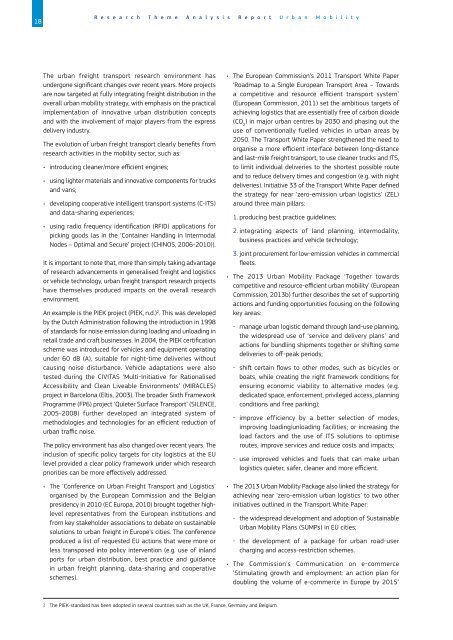Research Theme Analysis Report Urban Mobility
TRIP_Urban_Mobility_brochure-12.04.2016.pdf?utm_content=buffer91143&utm_medium=social&utm_source=twitter
TRIP_Urban_Mobility_brochure-12.04.2016.pdf?utm_content=buffer91143&utm_medium=social&utm_source=twitter
Create successful ePaper yourself
Turn your PDF publications into a flip-book with our unique Google optimized e-Paper software.
18<br />
R e s e a r c h T h e m e A n a l y s i s R e p o r t U r b a n M o b i l i t y<br />
The urban freight transport research environment has<br />
undergone significant changes over recent years. More projects<br />
are now targeted at fully integrating freight distribution in the<br />
overall urban mobility strategy, with emphasis on the practical<br />
implementation of innovative urban distribution concepts<br />
and with the involvement of major players from the express<br />
delivery industry.<br />
The evolution of urban freight transport clearly benefits from<br />
research activities in the mobility sector, such as:<br />
• introducing cleaner/more efficient engines;<br />
• using lighter materials and innovative components for trucks<br />
and vans;<br />
• developing cooperative intelligent transport systems (C-ITS)<br />
and data-sharing experiences;<br />
• using radio frequency identification (RFID) applications for<br />
picking goods (as in the ‘Container Handling in Intermodal<br />
Nodes – Optimal and Secure’ project (CHINOS, 2006-2010)).<br />
It is important to note that, more than simply taking advantage<br />
of research advancements in generalised freight and logistics<br />
or vehicle technology, urban freight transport research projects<br />
have themselves produced impacts on the overall research<br />
environment.<br />
An example is the PIEK project (PIEK, n.d.) 2 . This was developed<br />
by the Dutch Administration following the introduction in 1998<br />
of standards for noise emission during loading and unloading in<br />
retail trade and craft businesses. In 2004, the PIEK certification<br />
scheme was introduced for vehicles and equipment operating<br />
under 60 dB (A), suitable for night-time deliveries without<br />
causing noise disturbance. Vehicle adaptations were also<br />
tested during the CIVITAS ‘Multi-Initiative for Rationalised<br />
Accessibility and Clean Liveable Environments’ (MIRACLES)<br />
project in Barcelona (Eltis, 2003). The broader Sixth Framework<br />
Programme (FP6) project ‘Quieter Surface Transport’ (SILENCE,<br />
2005-2008) further developed an integrated system of<br />
methodologies and technologies for an efficient reduction of<br />
urban traffic noise.<br />
The policy environment has also changed over recent years. The<br />
inclusion of specific policy targets for city logistics at the EU<br />
level provided a clear policy framework under which research<br />
priorities can be more effectively addressed.<br />
• The ‘Conference on <strong>Urban</strong> Freight Transport and Logistics’<br />
organised by the European Commission and the Belgian<br />
presidency in 2010 (EC Europa, 2010) brought together highlevel<br />
representatives from the European institutions and<br />
from key stakeholder associations to debate on sustainable<br />
solutions to urban freight in Europe’s cities. The conference<br />
produced a list of requested EU actions that were more or<br />
less transposed into policy intervention (e.g. use of inland<br />
ports for urban distribution, best practice and guidance<br />
in urban freight planning, data-sharing and cooperative<br />
schemes).<br />
• The European Commission’s 2011 Transport White Paper<br />
‘Roadmap to a Single European Transport Area – Towards<br />
a competitive and resource efficient transport system’<br />
(European Commission, 2011) set the ambitious targets of<br />
achieving logistics that are essentially free of carbon dioxide<br />
(CO 2<br />
) in major urban centres by 2030 and phasing out the<br />
use of conventionally fuelled vehicles in urban areas by<br />
2050. The Transport White Paper strengthened the need to<br />
organise a more efficient interface between long-distance<br />
and last-mile freight transport, to use cleaner trucks and ITS,<br />
to limit individual deliveries to the shortest possible route<br />
and to reduce delivery times and congestion (e.g. with night<br />
deliveries). Initiative 33 of the Transport White Paper defined<br />
the strategy for near ‘zero-emission urban logistics’ (ZEL)<br />
around three main pillars:<br />
1. producing best practice guidelines;<br />
2. integrating aspects of land planning, intermodality,<br />
business practices and vehicle technology;<br />
3. joint procurement for low-emission vehicles in commercial<br />
fleets.<br />
• The 2013 <strong>Urban</strong> <strong>Mobility</strong> Package ‘Together towards<br />
competitive and resource-efficient urban mobility’ (European<br />
Commission, 2013b) further describes the set of supporting<br />
actions and funding opportunities focusing on the following<br />
key areas:<br />
--<br />
manage urban logistic demand through land-use planning,<br />
the widespread use of ‘service and delivery plans’ and<br />
actions for bundling shipments together or shifting some<br />
deliveries to off-peak periods;<br />
--<br />
shift certain flows to other modes, such as bicycles or<br />
boats, while creating the right framework conditions for<br />
ensuring economic viability to alternative modes (e.g.<br />
dedicated space, enforcement, privileged access, planning<br />
conditions and free parking);<br />
--<br />
improve efficiency by a better selection of modes,<br />
improving loading/unloading facilities; or increasing the<br />
load factors and the use of ITS solutions to optimise<br />
routes, improve services and reduce costs and impacts;<br />
--<br />
use improved vehicles and fuels that can make urban<br />
logistics quieter, safer, cleaner and more efficient.<br />
• The 2013 <strong>Urban</strong> <strong>Mobility</strong> Package also linked the strategy for<br />
achieving near ‘zero-emission urban logistics’ to two other<br />
initiatives outlined in the Transport White Paper:<br />
--<br />
the widespread development and adoption of Sustainable<br />
<strong>Urban</strong> <strong>Mobility</strong> Plans (SUMPs) in EU cities;<br />
--<br />
the development of a package for urban road-user<br />
charging and access-restriction schemes.<br />
• The Commission’s Communication on e-commerce<br />
‘Stimulating growth and employment: an action plan for<br />
doubling the volume of e-commerce in Europe by 2015’<br />
2 The PIEK-standard has been adopted in several countries such as the UK, France, Germany and Belgium.


